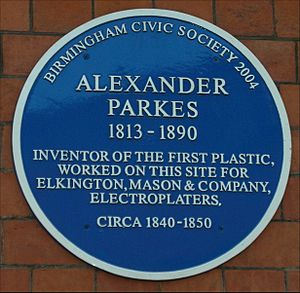Alexander Parkes facts for kids
Quick facts for kids
Alexander Parkes
|
|
|---|---|
| Born | 29 December 1813 Suffolk Street, Birmingham, England
|
| Died | 29 June 1890 (aged 76) |
| Nationality | English |
| Occupation | Engineer |
| Engineering career | |
| Projects | Parkesine |
Alexander Parkes (born December 29, 1813 – died June 29, 1890) was a clever inventor from Birmingham, England. He was a metallurgist, which means he studied metals. Parkes is most famous for creating Parkesine, which was the very first man-made plastic. His work changed how we make many things today.
Contents
Alexander Parkes' Life and Inventions
Alexander Parkes was the son of a man who made brass locks. He learned about working with metal at a brass foundry called Messenger and Sons. Later, he worked for George and Henry Elkington, who were famous for a process called electroplating. Electroplating uses electricity to put a thin layer of metal onto an object.
Parkes was put in charge of the casting department. He quickly became very interested in electroplating. In 1841, he got his first patent for a way to electroplate delicate things. He improved this method in 1843. His new way could electroplate fragile objects, like flowers. He even silver-plated a spider's web for Prince Albert when he visited the Elkington factory in 1844.
Parkes held at least 66 patents during his life. Most of these were about electroplating or developing new plastics.
Key Discoveries and Patents
- In 1846, he patented a "cold cure" process for making vulcanized rubber. This was a very important discovery for rubber production.
- He was a pioneer in adding small amounts of phosphorus to metals. This led to the creation of phosphor-bronze, which he patented with his brother Henry in 1848.
- In 1850, he developed the Parkes process. This was an affordable way to remove silver from lead. He patented more improvements to this process in 1851 and 1852.
- In 1856, he patented Parkesine. This was the first thermoplastic, which is a type of plastic that can be melted and reshaped. Parkesine was made from nitrocellulose and different chemicals. He showed this new material at an exhibition in London in 1862. It showed how plastics could be used for many beautiful and useful things.
- In 1866, Parkes started The Parkesine Company in London. He wanted to make Parkesine cheaply and in large amounts. However, it was expensive to make, often cracked, and caught fire easily. Because of these problems, the company closed in 1868.
- Later, Parkes's material was improved by his friend Daniel Spill. Spill called his improved version Xylonite. Another inventor, John Wesley Hyatt, also developed celluloid in the United States. Spill tried to sue Hyatt, saying Hyatt copied Parkes's idea. In 1870, a judge decided that Alexander Parkes was the true inventor because of his original experiments.
Family and Personal Life
Alexander Parkes was born in Birmingham. He was the fourth son of James Mears Parkes and Kerenhappuch Childs. Alexander Parkes was married twice. With his first wife, Jane Henshall Moore, he had four sons and two daughters. With his second wife, Mary Ann Roderick, he had four sons and seven daughters.
His younger brother, Henry Parkes, was a trained chemist. Henry helped Alexander with many of his experiments for over fifty years. Alexander's son, Alexander Parkes junior, later gave many original pieces of Parkesine to the Science Museum in 1937. These pieces are now a very important part of the museum's collection.
Parkes' Lasting Impact
Alexander Parkes is remembered in several places:
- The Plastics Historical Society put a blue plaque on his home in Dulwich, London, in 2002. A blue plaque is a special sign that marks a building where a famous person lived or worked.
- The Birmingham Civic Society also put a blue plaque for him in 2004. This plaque is on the old Elkington Silver Electroplating Works in Birmingham, which is now part of the Thinktank Science Museum.
- There is also a plaque on the wall where the Parkesine Works used to be.
In September 2005, Parkes was honored by being added to the American Plastics Hall of Fame. He is buried in West Norwood Cemetery in London.
See also
 In Spanish: Alexander Parkes para niños
In Spanish: Alexander Parkes para niños


